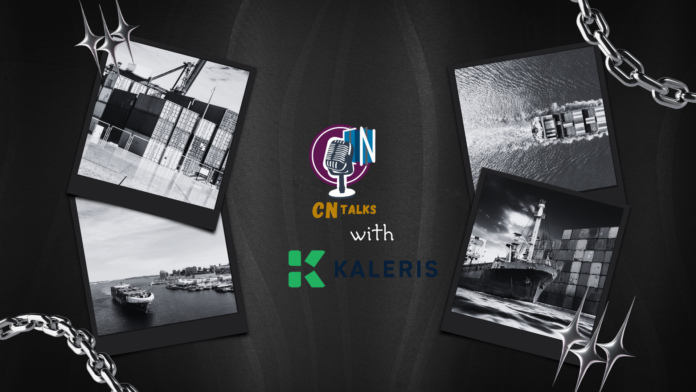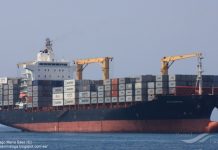
In this exclusive interview, Container News Managing Editor Antonis Karamalegkos, speaks with Carlos Lopez Barbera, Vice President of Products at Kaleris. Carlos shares his insights on the evolution of terminal operating systems, the rising importance of automation, and how global disruptions are reshaping the industry’s technological demands.
Would you like to introduce yourself to our readers, giving us a brief about your role in Kaleris?
I am the Vice President of Products at Kaleris, which used to be known as Navis.
Now, with Kaleris, the family is a little bit bigger, but the terminal operating system
(TOS) continues to be one of our core businesses. I’ve been with the company for
about 13 years, and I’ve been in the industry for roughly 16 years now. During that
time, I’ve had the opportunity to work on different projects for container terminals,
always related to TOS. Many of those projects were related to automation and
optimization of container terminals. So that has been a huge part of my career
since I joined the industry.
Would you like to give us an overview of how terminal operating systems have evolved in recent years and how new technologies have contributed to this change?
It’s been very interesting to be close to the evolution of TOS. At the end of the day, I
think the role of the TOS has become more critical over the years. If I go back 10–15
years, the TOS was more like a planning tool. It supported operations, but in many
cases, if the system wasn’t available, some terminals could continue running
operations manually until the system came back online. It was a nice graphical tool
that helped vessel planners, yard planners, and operations teams to manage
operations, but it wasn’t as critical as it is today.
Now, it’s hard to believe that a terminal could switch to manual operations if the
system went down. Today, it’s a completely mission-critical system. Our customers
rely on the TOS to run operations and make real-time decisions. If the system is
down, the terminal practically stops.
That shift has been significant, and it impacts how we build the software. We need
to think about scalability, system availability, and more. It’s a system that needs to
run 24/7, delivering the performance and flexibility that our customers need, based
on how their business is evolving.
So, it has transitioned from being more of a planning tool to a fully operational
system that customers completely rely on. Of course, we could go deeper into the
technologies and changes that made this possible, but the biggest shift is how
mission-critical it has become.
Were there any specific highlights or milestones in that transition from a planning tool to a necessary feature of current terminals?
Yeah, absolutely. The way our customers handle operations has also become more complex. So, we had to think about two things: on one hand, we need scalability and system availability; on the other hand, the system needs to become smarter.
Our customers are handling more volume every day, often with the same space. If you look back over the last 10 years, many of our customers are handling 30% more volume, often in the same physical footprint. Sometimes, they can expand a bit or add more equipment, but in many cases, it’s just the same space—30% busier. How do you manage that?
They’re so busy they don’t have time for system downtime, whether it’s planned or unplanned. At the same time, they need the system to evolve and become smarter. They need tools that support the users and terminal operations every day.
Human operators alone can’t scale to the level needed to manage today’s volume and flexibility—services change on the fly, yard utilization can jump from 50% to 80%. Things are so dynamic and complex now that you need a smart system. Many of the tools we’re building fall into that category.
To summarize, what you’ll see in our roadmap and strategy are two fundamental pillars: one is to ensure the system scales and remains stable—that’s the technology side of the TOS. The second is optimization—all the tools and features that make tasks smarter and provide the added efficiency our customers need. Everything else is built on top of those two pillars.
Do you see increased demand for terminal operating systems during crisis periods? For instance, we’ve seen the Red Sea crisis, the Ukraine war, recent protectionist measures by the U.S. with tariffs, and of course, the COVID crisis. Do you see higher demand from clients in such challenging periods?
If you go back 10 years, you’d see that customer operations were more stable—they had similar services every week, more repetitive routines. They also had more days without operations, so they had more time to prepare. If they needed to do a server or system upgrade, they could plan during those windows. They were dealing with the same services regularly, and they knew what to expect. Volumes were also more stable—maybe 40%, 50%, 60% yard utilization. That was the old scenario.
Now, they’re not only busier, but they’re also facing all these crises. For example, during COVID, terminals suddenly weren’t busy because people were afraid and uncertain—demand dropped. Then, as people began working from home, demand spiked—everyone was ordering desks, office supplies, shopping online. Consumer behavior changed
drastically. Volumes came back in a big way, but we didn’t have enough trucks to move those containers, so terminals became storage facilities to some extent.
With tariffs, some customers had similar fears for lower volumes. Then things stabilized, agreements were made, and volumes came back all at once—terminals got busy again. The level of flexibility required today is entirely different. That’s a new kind of demand—they need systems that can adapt quickly to fluctuating circumstances. One day the yard is at 40% capacity, the next it’s at 80%.
They don’t have time or resources to change strategies overnight, so they need a system that behaves differently. Also, they no longer have those “windows” they used to have to get ready for the next operation. Everything happens on the fly now. They need more intelligence and robustness in the system than ever before. This wasn’t the case 10 years ago—this is a recent phenomenon, that we have seen especially after the Covid period.
Are there any notable geographical trends or characteristics among your client base? And beyond your clients, do you see any specific regional trends in the TOS market?
Yes, definitely. It has always been the case that different regions behave differently. For instance, in some regions, labor costs or talent availability are bigger concerns than in others.
One recent change I’ve noticed is in parts of Asia and Latin America—regions that previously had little interest in automation or technologies that automate equipment or processes. I think the reason was that labor costs weren’t a significant concern in those countries, so the business case for automation wasn’t strong. But now, that’s changing.
Labor costs are rising as these countries become more advanced, and technology itself has evolved.
Previously, if you wanted to automate a container terminal, you had to build it from scratch—a massive project involving civil works and long timelines. Now, with technologies like automated RTGs or automated trucks, you can retrofit existing operations. You don’t have to do it all at once—you can start with a few yard cranes or trucks, and the manual and automated systems can coexist.
That’s changing the dynamic in how these economies are approaching automation. In Latin America, for example, there are now multiple terminals planning to automate step by step—one crane at a time, a few trucks at a time. Technology now allows this kind of gradual transition. We’ve recognized this and have made sure that our TOS supports that stepwise approach. One crane at a time, one truck at a time—customers can adopt automation at a comfortable pace. I believe this is the path many terminals, especially in countries where automation wasn’t previously feasible, will begin to follow.
Is there any difference in your approach when working with a less developed terminal compared to a more established one?
Yes, there is. Automation is one of the key reasons that made us start thinking differently. But another major trend is the shift away from new terminals. We no longer see as many greenfield terminals being built. Most of the work today is in brownfield sites—existing terminals that are expanding or changing their operating models.
Ten or fifteen years ago, innovation often happened in greenfield terminals. These terminals had no customers or volumes, so the risk was lower. You could introduce new technology without disrupting anything. You had time to ramp up and stabilize.
Now, with existing terminals being the focus, the challenge is that they’re already busy and running at high utilization. They don’t have the luxury of time or downtime. So we’ve had to change our approach entirely.
Today, innovation must happen in live environments, step by step. Customers want to implement improvements gradually and mitigate risk. They can’t afford to reduce the service level they’re providing. You have to de-risk the process. Whether it’s automation—adding one automated RTG at a time—or deploying a new optimization tool, the approach is the same. You can’t do a “big bang” rollout. You might start with one block in the
yard or one truck and expand from there.
It’s not just about the solution working technically—it’s also about change management. A solution might be excellent, but if people aren’t used to it, it will cause problems. So we focus on progressive rollouts that allow teams to become comfortable and see results.
The software has to be built to support this. For example, if you have a terminal with 25 RTGs, 20 might still run on the old system while five move to the new one. Then you go from five to 10 to 15 and so on. That way, innovation continues without disrupting operations. This is how we keep pushing the industry forward.
Is training personnel another challenge in that implementation process?
Yes—training and change management are both critical. In some cases, it’s about
people being used to doing things a certain way for many years. When you suddenly
change processes across an entire terminal with hundreds of employees, it can be
chaotic.
If you’re dealing with a greenfield site, a little chaos is okay—you have time to
recover. But if you’re a terminal moving 5 million TEUs a year, that’s a huge risk.
Take PTP in Malaysia, for instance, with which we are collaborating. They handle
more than 10 million TEUs a year. It’s a massive operation—56 quay cranes, 250
RTGs, 500 trucks. Imagine thousands of employees. You can’t change everything at
once. So they do it in phases.
They designate a small part of the terminal—a few yard cranes, a few trucks—as a
test area. They rotate staff in and out of that zone, training them on the new
process. Over time, those people become the champions of the new solution and
help spread it across the rest of the facility.
What about new vulnerabilities and cybersecurity challenges arising from new technologies in the industry?
Cybersecurity wasn’t really on anyone’s agenda 10 years ago. The TOS was
usually deployed on-premise, within the customer’s own infrastructure.
Beyond basic security, vulnerabilities weren’t top of mind. Maybe a customer
would ask now and then, but it wasn’t a major concern.
That has changed completely. Today, cybersecurity is a major priority—even
for on-premise deployments. It’s not something you fix once and forget. It’s
an ongoing process.
For example, we use third-party libraries in our software. When those
libraries are updated for security, we have to update them in our software and
deliver new versions. We now have continuous programs to detect
vulnerabilities. We work with third parties to audit our solutions. They
provide lists of issues to fix, and we prioritize them by severity. We also have
protocols to notify customers about new software versions that contain
security fixes.
Today’s environments are hybrid. A TOS might be on-premise but connected
to cloud services, third-party systems, or community systems. Data flows
across systems, so the architecture must be designed accordingly.
Lastly, regulations differ by region. Europe has one set of rules, Asia another.
Some countries require solutions to be hosted locally. We must adapt to all of
these requirements.
Cybersecurity has become a major part of our strategy and roadmap because
it’s what the market demands—and we take it very seriously.





